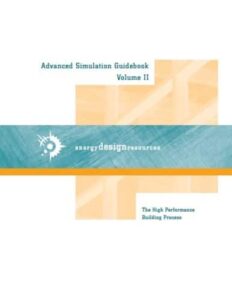Advanced Simulation Guidebook Volume II – The High Performance Building Process
Advanced Simulation Guidebook Volume II -The High Performance Building Process
This second volume of the Advanced Simulation Guidebook Volume II intended to teach readers about the high performance building process for commercial new construction. The goal of the high performance building process is to create buildings that meet owner and occupant needs in terms of energy efficiency, thermal comfort, and other sustainability areas—and do so in a way that reduces the necessary design effort and construction cost impact.
The fact that we are discussing the “high performance” building process implies that the typical way of creating buildings is “low performance”, but this is not the case. Rather, the traditional design and construction process has, for most buildings, been optimized to minimize the initial investment. The ‘trickle down’ effects of first cost minimization, aside from the obvious impact on building systems selection, include compression of the project schedule, reduced design fees, and reduction or elimination of quality assurance functions such as commissioning. This puts architects and engineers in a position where they have neither the time nor budget to design more innovative buildings. They often discouraged from veering from tried-and-true design solutions. Given this, it is not surprising that many new buildings look a lot like each other.
You can also Read Air Conditioning System Design 1st Edition
Advanced Simulation Guidebook Volume II Content
- Introduction
![Advanced Simulation Guidebook Volume II]()
- The High Performance Building Process
- Using Simulation to Guide the High Performance Building Process
- Energy Modeling Approach for Specific Programs
- Site-Generated Renewable Energy
- Summary
The first part of this guidebook addresses the high performance building process, and how energy modeling used to help project stakeholders make better informed design decisions. Specific ways that energy modeling used to support the high performance building process during each design phase discussed. The second part of this guidebook addresses program-specific documentation requirements for Savings By Design, LEED for New Construction version 2.2.
A central component of the high performance building process is that the energy efficiency and cost-effectiveness of design decisions improved through effective use of energy modeling during all design phases of a project. The challenge to the energy modeler is to understand which questions effectively answered with the energy model at each project phase. Just as the overall design starts with a broad focus during schematic design and increases in detail through subsequent phases, so too must the energy model start as a somewhat simplified depiction of what the final project will be and then be refined as more detailed information becomes available.


Comments are closed.